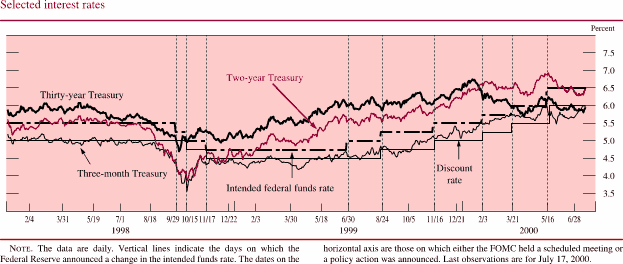
Monetary Policy Report forwarded to the Congress on July 20, 2000
Section 1
MONETARY POLICY AND THE ECONOMIC OUTLOOK
The impressive performance of the U.S. economy persisted in the first half of 2000 with economic activity expanding at a rapid pace. Overall rates of inflation were noticeably higher, largely as a result of steep increases in energy prices. The remarkable wave of new technologies and the associated surge in capital investment have continued to boost potential supply and to help contain price pressures at high levels of labor resource use. At the same time, rising productivity growth--working through its effects on wealth and consumption, as well as on investment spending--has been one of the important factors contributing to rapid increases in aggregate demand that have exceeded even the stepped-up increases in potential supply. Under such circumstances, and with the pool of available labor already at an unusually low level, the continued expansion of aggregate demand in excess of the growth in potential supply increasingly threatened to set off greater price pressures. Because price stability is essential to achieving maximum sustainable economic growth, heading off these pressures has been critical to extending the extraordinary performance of the U.S. economy.
To promote balance between aggregate demand and potential supply and to contain inflation pressures, the Federal Open Market Committee (FOMC) took additional firming actions this year, raising the benchmark federal funds rate 1 percentage point between February and May. The tighter stance of monetary policy, along with the ongoing strength of credit demands, has led to less accommodative financial conditions: On balance, since the beginning of the year, real interest rates have increased, equity prices have changed little after a sizable run-up in 1999, and lenders have become more cautious about extending credit, especially to marginal borrowers. Still, households and businesses have continued to borrow at a rapid pace, and the growth of M2 remained relatively robust, despite the rise in market interest rates. The favorable outlook for the U.S. economy has contributed to a further strengthening of the dollar, despite tighter monetary policy and rising interest rates in most other industrial countries.
Perhaps partly reflecting firmer financial conditions, the incoming economic data since May have suggested some moderation in the growth of aggregate demand. Nonetheless, labor markets remained tight at the time of the FOMC meeting in June, and it was unclear whether the slowdown represented a decisive shift to more sustainable growth or just a pause. The Committee left the stance of policy unchanged but saw the balance of risks to the economic outlook as still weighted toward rising inflation.
Monetary Policy, Financial Markets, and the Economy over the First Half of 2000
When the FOMC convened for its first two meetings of the year, in February and March, economic conditions in the United States were pointing toward an increasingly taut labor market as a consequence of a persistent imbalance between the growth rates of aggregate demand and potential aggregate supply. Reflecting the underlying strength in spending and expectations of tighter monetary policy, market interest rates were rising, especially after the century date change passed without incident. But, at the same time, equity prices were still posting appreciable gains on net. Knowing that the two safety valves that had been keeping underlying inflation from picking up until then--the economy's ability to draw on the pool of available workers and to expand its trade deficit on reasonable terms--could not be counted on indefinitely, the FOMC voted for a further tightening in monetary policy at both its February and its March meetings, raising the target for the overnight federal funds rate 25 basis points on each occasion. In related actions, the Board of Governors also approved quarter-point increases in the discount rate in both February and March.
